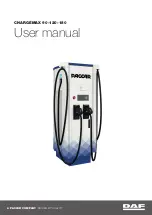
If you are checking tire pressure when the tire is hot, (i.e. driven more
than 1 mile [1.6 km]), never “bleed” or reduce air pressure. The tires are
hot from driving and it is normal for pressures to increase above
recommended cold pressures. A hot tire at or below recommended cold
inflation pressure could be significantly under-inflated.
To check the pressure in your tire(s):
1. Make sure the tires are cool, meaning they are not hot from driving
even a mile.
Note:
If you have to drive a distance to get air for your tire(s), check
and record the tire pressure first and add the appropriate air pressure
when you get to the pump. It is normal for tires to heat up and the air
pressure inside to go up as you drive. Never “bleed” or reduce air
pressure when tires are hot.
2. Remove the cap from the valve on one tire, then firmly press the tire
gauge onto the valve and measure the pressure.
3. Add enough air to reach the recommended air pressure
Note:
If you overfill the tire, release air by pushing on the metal stem in
the center of the valve. Then recheck the pressure with your tire gauge.
4. Replace the valve cap.
5. Repeat this procedure for each tire, including the spare.
Note:
Some spare tires operate at a higher inflation pressure than the
other tires. For T-type/mini-spare tires (see
T-Type/Mini-Spare Tire
Information
section for description): Store and maintain at 60psi (4.15
bar). For Full Size and Dissimilar spare tires (see
Dissimilar Spare
Tire/Wheel Information
section for description): Store and maintain at
the higher of the front and rear inflation pressure as shown on Safety
Compliance Certification Label or the Tire Label.
6. Visually inspect the tires to make sure there are no nails or other
objects embedded that could poke a hole in the tire and cause an air
leak.
7. Check the sidewalls to make sure there are no gouges, cuts or bulges.
INFORMATION CONTAINED ON THE TIRE SIDEWALL
Both U.S. and Canada Federal regulations require tire manufacturers to
place standardized information on the sidewall of all tires. This
information identifies and describes the fundamental characteristics of
the tire and also provides a U.S. DOT Tire Identification Number for
safety standard certification and in case of a recall.
2006 Mountaineer
(mnt)
Owners Guide (post-2002-fmt)
USA
(fus)
Tires, Wheels and Loading
186
Summary of Contents for 2006 Mountaineer
Page 327: ...2006 Mountaineer mnt Owners Guide post 2002 fmt USA fus Maintenance and Specifications 327 ...
Page 338: ...338 ...
Page 339: ...339 ...
Page 340: ...340 ...
Page 341: ...341 ...
Page 342: ...342 ...
Page 343: ...343 ...
Page 344: ...344 ...
















































